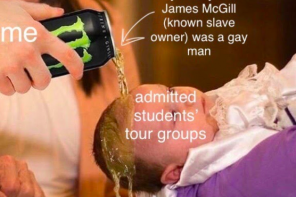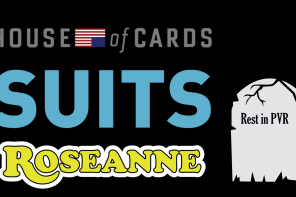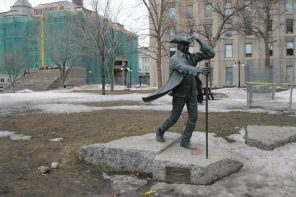(Warning: spoilers ahead for Breaking Bad and Better Call Saul)
If you search “James McGill” on Google, you’ll be greeted not only by the controversial namesake of our school, but also several results for the television character more commonly known as Saul Goodman. The statement, “Better Call Saul is about Saul Goodman” seems indisputable. After all, Saul Goodman is the main character of the show, and some would even posit that he is the main character of the entire Breaking Bad universe. I would push back on this statement. To me, the final episodes of Better Call Saul, especially the aptly titled finale “Saul Gone,” confirm that Better Call Saul (and perhaps the entire Breaking Bad universe) is about the rise and fall of James “Slippin’ Jimmy” McGill. Whether he poses as Jimmy McGill, Saul Goodman, or Gene Takavic (his final alias), the criminal lawyer from Albuquerque has always, at heart, been the same person. Did the final episodes of Better Call Saul do his character justice? To answer this loaded question, we must analyze exactly how Vince Gilligan and Peter Gould highlight the complexities of Saul Goodman and consider the broader context of Breaking Bad.
Viewers are left wondering if Walter has truly evolved at the series’s conclusion or if he simply tied up his loose ends out of self-interest.
The finale of Breaking Bad, “Felina,” felt like the perfect goodbye to Walter White. Despite all the horrible things Walter did during the two years following his lung cancer diagnosis, many viewers still rooted for his success and survival. By the end of the show, Walter’s actions were irredeemable, but he still went out with purpose, doing what he could to right some of the wrongs he was responsible for. For example, he got Walt Junior his money and brutally murdered Hank’s killers. He even executed fan-least-favorite Lydia, finally utilizing the ricin that had stirred up so much turmoil for him and Jesse. Walter’s actions do not derive from moral benevolence, nor are they purely a manifestation of Walter’s guilt, but the ambiguity of Walter’s actions exemplifies why he is such a complex, well-written character. Viewers are left wondering if Walter has truly evolved at the series’s conclusion or if he simply tied up his loose ends out of self-interest.
Better Call Saul ends on a darker note, as Saul, operating as Gene Takavic in Omaha, finally gets his comeuppance: he is placed under arrest. I had looked forward to the Better Call Saul finale for months over the summer, and after watching “Breaking Bad” and “Waterworks,” episodes eleven and twelve of Better Call Saul’s sixth season, I couldn’t help but worry that Vince Gilligan and Peter Gould, regardless of how consistently excellent their writing was, were setting up for a lacklustre conclusion. We got the cameos from Walter and Jesse that we had yearned for, along with a pseudo-cameo from Kim Wexler in the Gene timeline. However, by the end of the penultimate episode, I felt that the writers had left little room for any truly earth-shattering events in the finale. Thankfully, despite accurately predicting the lack of unforeseeable twists, I was very impressed by “Saul Gone,” and the series ending with Saul Goodman in the courtroom simply felt right.
The inclusion of several flashbacks was a critical component of the Better Call Saul finale, adding layers of depth and context to the storyline and Saul’s eventual downfall. In each of the three flashbacks, Saul converses with someone who has changed his life, sharing tense, meaningful moments with Mike, Walter, and Chuck, who each serve as foils for Saul.
Mike tells Saul that if he had a time machine, he would go back to the day he accepted his first bribe. After initially mentioning the day his son died, Mike changes his mind, taking full responsibility for the ripple effect of his amoral actions. He realizes that his acceptance of the bribe led to his son’s death and many other painful moments. Saul sees things differently though — he says he would use the time machine to play the stock market and make millions of dollars. This conversation takes place during Saul’s trek through the desert, a life-changing, traumatic experience brought about by his greed and willingness to work for the cartel. Still, Saul fails to see the irony of his proclamation. Mike’s cold-blooded accountability juxtaposes Saul’s complete inability to take responsibility for his own actions.
Deep in an underground bunker, waiting for his new identity, Saul still cannot confront his mistakes — or perhaps he does not see them as mistakes at all.
Walt, on the other hand, questions the validity of the time machine scenario, calling Saul’s query a “meaningless question” as he breaks down the concept of time travel as scientifically as he can. Eventually, Walt admits that he regrets leaving Gray Matter Technologies and that he would not be in hiding with Saul if he had stuck with the company. Walt’s response evokes Saul’s perpetual opportunistic streak; as Saul describes the legal action he could have brought down on Elliott and Gretchen Schwartz, Walt’s former business partners, he displays the exact personality trait that led to the predicament he finds himself in — he always wants more. Even Walter White, who openly admits to enjoying his crystal meth dynasty, expresses regret that his life reached the point it did. Deep in an underground bunker, waiting for his new identity, Saul still cannot confront his mistakes — or perhaps he does not see them as mistakes at all.
Chuck, who consistently brings out Jimmy’s (Saul’s) vulnerability throughout the show, attempts to have a heartfelt conversation, telling him that it isn’t too late to change his path. Jimmy deflects and brushes Chuck’s words aside, and Chuck, who knows his brother better than anyone else, watches Jimmy leave and continue his descent into the criminal underworld. Chuck’s concerned but accepting face echoes the emotions of viewers, and the magnitude of this scene is immense given Chuck’s untimely demise earlier in the show. All three characters who speak to Saul in the flashbacks are dead — and their conversations with Saul highlight the characteristics that led Saul to indirectly cause all three of their deaths.
Was the ending of Better Call Saul perfect? No, but it didn’t need to be.
These flashbacks are critical in helping viewers understand who Saul Goodman truly is — or rather, who Jimmy McGill truly is. Vince Gilligan and Peter Gould perfectly encapsulate Jimmy’s character through his relationship with someone who did not make a single appearance in Breaking Bad: Kim Wexler, Jimmy’s ex-wife. As Jimmy confesses his crimes and proclaims his selfish greed, his counsel, Bill Oakley, pleads with the judge, attempting to defend his client. Jimmy, having already made up his mind, accepts his fate, as he has finally told Kim the unfiltered truth. No charade, no lies, no more waterworks – Jimmy reclaims his identity and goes out on his own terms. As Jimmy shares a cigarette with Kim during her visit to his prison, he seems to accept what his life has become. Even if Jimmy wishes his story ended differently, he understands why his downfall has taken place. In the black and white Gene timeline, the cigarette flickers in color, providing a final glimpse of the colorful life Jimmy once led.
Was the ending of Better Call Saul perfect? No, but it didn’t need to be. Creating an ending that does justice to a character like Jimmy McGill is a challenge, but Vince Gilligan and Peter Gould stepped up to the task, breaking down Jimmy’s character in a manner that truly takes viewers inside Jimmy’s head. The true letdown of Better Call Saul comes from the fact that one of the greatest television franchises ever created has to come to an end.
***
Graphic by Annette Archaeni





